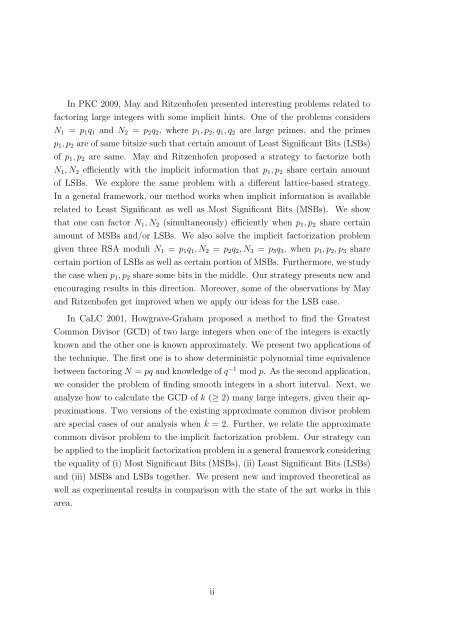Cryptanalysis of RSA Factorization - Library(ISI Kolkata) - Indian ...
Cryptanalysis of RSA Factorization - Library(ISI Kolkata) - Indian ...
Cryptanalysis of RSA Factorization - Library(ISI Kolkata) - Indian ...
Create successful ePaper yourself
Turn your PDF publications into a flip-book with our unique Google optimized e-Paper software.
In PKC 2009, May and Ritzenh<strong>of</strong>en presented interesting problems related to<br />
factoring large integers with some implicit hints. One <strong>of</strong> the problems considers<br />
N 1 = p 1 q 1 and N 2 = p 2 q 2 , where p 1 ,p 2 ,q 1 ,q 2 are large primes, and the primes<br />
p 1 ,p 2 are <strong>of</strong> same bitsize such that certain amount <strong>of</strong> Least Significant Bits (LSBs)<br />
<strong>of</strong> p 1 ,p 2 are same. May and Ritzenh<strong>of</strong>en proposed a strategy to factorize both<br />
N 1 ,N 2 efficiently with the implicit information that p 1 ,p 2 share certain amount<br />
<strong>of</strong> LSBs. We explore the same problem with a different lattice-based strategy.<br />
In a general framework, our method works when implicit information is available<br />
related to Least Significant as well as Most Significant Bits (MSBs). We show<br />
that one can factor N 1 ,N 2 (simultaneously) efficiently when p 1 ,p 2 share certain<br />
amount <strong>of</strong> MSBs and/or LSBs. We also solve the implicit factorization problem<br />
given three <strong>RSA</strong> moduli N 1 = p 1 q 1 ,N 2 = p 2 q 2 ,N 3 = p 3 q 3 , when p 1 ,p 2 ,p 3 share<br />
certain portion <strong>of</strong> LSBs as well as certain portion <strong>of</strong> MSBs. Furthermore, we study<br />
the case when p 1 ,p 2 share some bits in the middle. Our strategy presents new and<br />
encouraging results in this direction. Moreover, some <strong>of</strong> the observations by May<br />
and Ritzenh<strong>of</strong>en get improved when we apply our ideas for the LSB case.<br />
In CaLC 2001, Howgrave-Graham proposed a method to find the Greatest<br />
Common Divisor (GCD) <strong>of</strong> two large integers when one <strong>of</strong> the integers is exactly<br />
known and the other one is known approximately. We present two applications <strong>of</strong><br />
the technique. The first one is to show deterministic polynomial time equivalence<br />
between factoring N = pq and knowledge <strong>of</strong> q −1 mod p. As the second application,<br />
we consider the problem <strong>of</strong> finding smooth integers in a short interval. Next, we<br />
analyze how to calculate the GCD <strong>of</strong> k (≥ 2) many large integers, given their approximations.<br />
Two versions <strong>of</strong> the existing approximate common divisor problem<br />
are special cases <strong>of</strong> our analysis when k = 2. Further, we relate the approximate<br />
common divisor problem to the implicit factorization problem. Our strategy can<br />
be applied to the implicit factorization problem in a general framework considering<br />
the equality <strong>of</strong> (i) Most Significant Bits (MSBs), (ii) Least Significant Bits (LSBs)<br />
and (iii) MSBs and LSBs together. We present new and improved theoretical as<br />
well as experimental results in comparison with the state <strong>of</strong> the art works in this<br />
area.<br />
ii
















